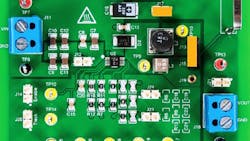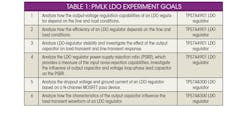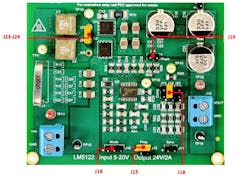Comprehensive, easy to use, and versatile, the TI-PMLK facilitates a learning environment that results in students applying the practical learning achieved through the lab experience toward designing their power-supply solutions. Each lab kit includes an evaluation board and experiment lab book covering key power-converter topologies, theory, case studies, and a set of unique experiments to jump-start understanding of power supplies that are required for real-life applications. Fig. 1 shows the LDO (low dropout) regulator board; Fig. 2 shows the buck converter board; and Fig. 3 shows the boost converter board.
You can use the series of boards and experiments to reinforce foundational theories taught in a variety of electrical-engineering courses, as well as to train industry professionals on how to make informed power-supply decisions for their designs. The TI-PMLK can be holistically taught in modular parts to accommodate curriculum or coursework needs, or to facilitate engineering training in the industry to address particular application challenges.
The main purpose of the PMLK collection of Experiment books is to stimulate the spirit of investigation in students and practicing engineers who are engaged in learning and understanding the power-supply design. The experiments cover a basic anthology of topics and issues encountered in the design of low-power, dc-dc, non-isolated power supplies, such as power-supply topologies and characteristics, modes of operation, efficiency, control, stability, accuracy, transient response, noise, power magnetics, and more.
The experiments can be performed by using the power-supply boards of the PMLK suite, which includes low-dropout linear regulators and buck, boost, and buck-boost switching regulators. The Experiment books are not intended to provide an exhaustive overview of design issues or definitive design hints: rather, they are meant to guide the reader into a multifaceted active learning experience. In particular, digital designers will benefit from learning about power supplies they rarely investigate.
This TI-PMLK series includes the most common power solutions found in the industry: buck, linear regulator (LDO), boost, and coming soon, buck-boost. Table 1 lists the LDO experiments; Table 2 lists the buck-converter experiments; and Table 3 covers the boost-converter experiments.
All experiments are based on a logical sequence of steps in three sections:
1. Case Study provides the description of the specific property or feature relevant to the power-supply board to be used in the experiment, and illustrates the goal and type of measurement to be done.
2. Theory Background offers a short summary of concepts, models, and equations supporting the interpretation and understanding of the incoming experimental observations.
3. Measurement Setup details instructions for connecting the instruments needed for the board-under-test experiments. Warnings are provided to prevent main mistakes.
Sessions:
1. Test provides instructions on how to execute the measurements, and guidelines on how to analyze and understand the results of the measurements.
2. Answer for each test is where the user is required to answer questions and provide a discussion about the behavior of the board under test, relevant to the specific performance under investigation. This is based on the observation of the measurements results and the application of concepts and properties illustrated through the various sections of the experiment.
3. Discussion provides comments to achieve a better understanding of conceptual and practical correlations among system characteristics and operating performance.
4. Experimental Plots illustrate and discuss the results of some sample measurements.
The books outline parameters of semiconductor and passive power components mounted in the boards, enabling the application of analysis formulas and design equations. Temperature, voltage, current, and frequency all influence the power and control components and sub-circuits of integrated circuits that control the power supplies, which in turn determine modes of operation and performance.
The ultimate intention of these books is to accompany the reader through an active experience, made of observations, application of physics and mathematics, reality investigation, and system-level reasoning.
About the Author

Sam Davis Blog
Editor-In-Chief - Power Electronics
Sam Davis was the editor-in-chief of Power Electronics Technology magazine and website that is now part of Electronic Design. He has 18 years experience in electronic engineering design and management, six years in public relations and 25 years as a trade press editor. He holds a BSEE from Case-Western Reserve University, and did graduate work at the same school and UCLA. Sam was the editor for PCIM, the predecessor to Power Electronics Technology, from 1984 to 2004. His engineering experience includes circuit and system design for Litton Systems, Bunker-Ramo, Rocketdyne, and Clevite Corporation.. Design tasks included analog circuits, display systems, power supplies, underwater ordnance systems, and test systems. He also served as a program manager for a Litton Systems Navy program.
Sam is the author of Computer Data Displays, a book published by Prentice-Hall in the U.S. and Japan in 1969. He is also a recipient of the Jesse Neal Award for trade press editorial excellence, and has one patent for naval ship construction that simplifies electronic system integration.







